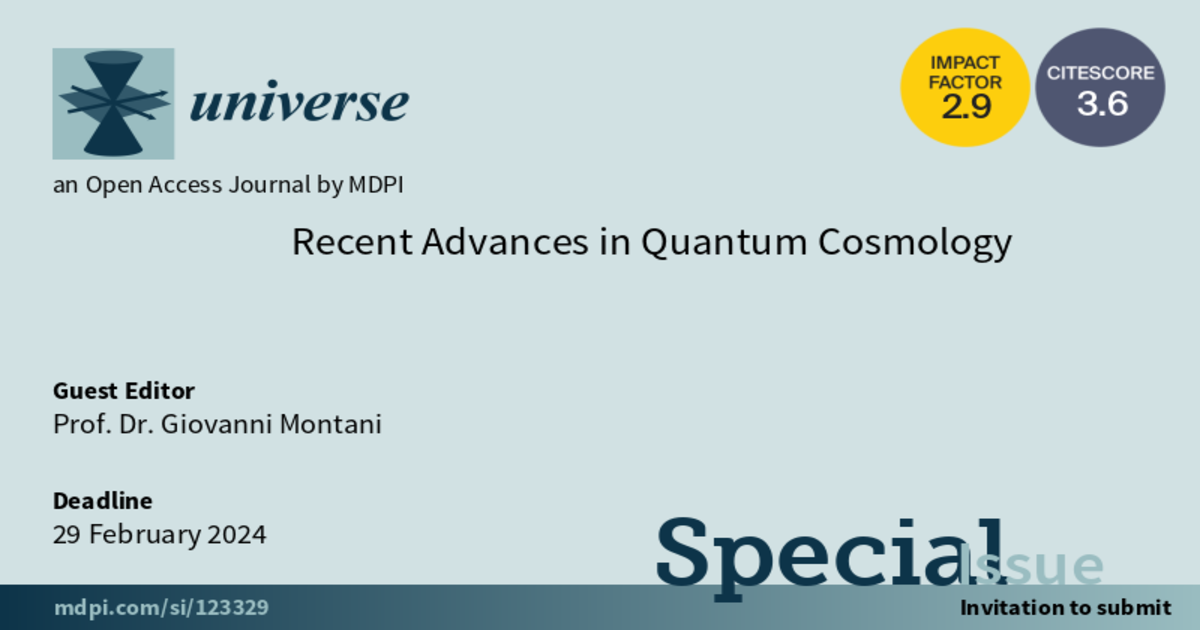Recent Advances in Quantum Cosmology
A special issue of Universe (ISSN 2218-1997). This special issue belongs to the section "Cosmology".
Deadline for manuscript submissions: closed (29 February 2024) | Viewed by 6382

Special Issue Editor
2. Physics Department, “Sapienza” University of Rome, P.le Aldo Moro 5, 00185 Roma, Italy
Interests: primordial cosmology; quantum gravity; modified theories of gravity; plasma astrophysics; cosmological plasmas; turbulent transport in plasmas
Special Issue Information
Dear Colleagues,
The dynamics of the quantum universe is an excellent arena to test the predictivity of different proposals for a quantum theory of gravity, and in some cases, the mini-superspace formulation is rich with physical insight.
In the last two decades, quantum cosmology has been characterized by a new impulse, mainly due to the formulation of Big-Bounce dynamics in Loop Quantum Cosmology. Further, other formulations based on a covariant description of the gravitational field dynamics have been successful in offering physical intuitions on the emergence of a classical Universe from the Planckian era.
Despite this improvement of our understanding about the notion and the meaning of a quantum universe, many relevant open questions remain in the field and call attention for further discussion and investigation. For this reason, the goal of this issue is to put together material coming from different approaches and try to find those common features which could constitute a valuable horizon for future studies.
This Special Issue aims at focusing attention on the most recent and promising developments in quantum cosmology, both in the canonical formulation, as well as in covariant approaches (e.g., path integral or covariant loop quantum gravity studies). Three main aspects are considered: (i) proposals for suitable clocks in quantum cosmologies; (ii) the implementation of fundamental symmetries in the mini-superspace; (iii) the emergence of Big-Bounce dynamics. Implications on universe quantum dynamics, coming from extended theories of gravity, are also considered. We invite the submission of original papers in the form of regular articles or short letters, but also review articles dedicated to selected topics in quantum cosmology.
Prof. Dr. Giovanni Montani
Guest Editor
Manuscript Submission Information
Manuscripts should be submitted online at www.mdpi.com by registering and logging in to this website. Once you are registered, click here to go to the submission form. Manuscripts can be submitted until the deadline. All submissions that pass pre-check are peer-reviewed. Accepted papers will be published continuously in the journal (as soon as accepted) and will be listed together on the special issue website. Research articles, review articles as well as short communications are invited. For planned papers, a title and short abstract (about 100 words) can be sent to the Editorial Office for announcement on this website.
Submitted manuscripts should not have been published previously, nor be under consideration for publication elsewhere (except conference proceedings papers). All manuscripts are thoroughly refereed through a single-blind peer-review process. A guide for authors and other relevant information for submission of manuscripts is available on the Instructions for Authors page. Universe is an international peer-reviewed open access monthly journal published by MDPI.
Please visit the Instructions for Authors page before submitting a manuscript. Submitted papers should be well formatted and use good English. Authors may use MDPI's English editing service prior to publication or during author revisions.
Keywords
- Big-Bounce scenarios
- time in quantum cosmology
- symmetries of the quantum universe
- canonical quantum cosmology
- covariant approaches to quantum cosmology
- quantum cosmology from extended gravity





